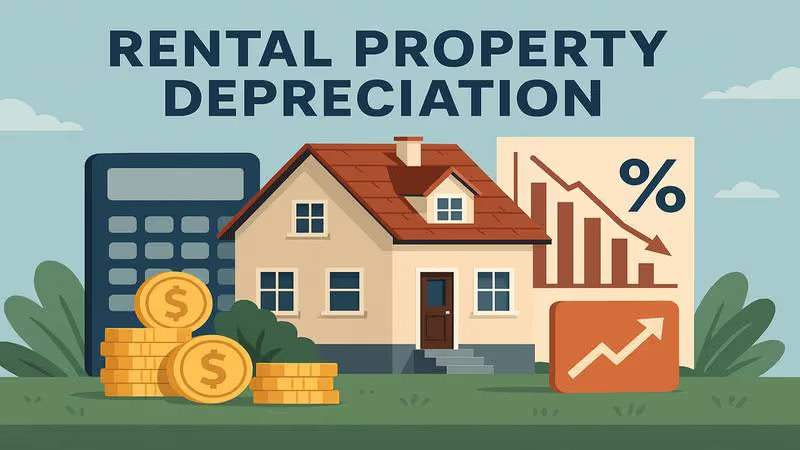Unlocking Cost Segregation Strategies to Maximize Rental Property Tax Benefits
Rental Property Depreciation Explained
If you're a rental property owner, you're likely aware of the various tax benefits available to you. One of the most valuable, yet often overlooked, deductions is depreciation. Depreciation allows you to reduce taxable income by deducting a portion of the property’s cost each year. The amount you can deduct depends on three key factors:
- your basis in the property
- the recovery period
- the depreciation method applied.
However, depreciation only applies to property used for rental purposes and can reduce your property's basis when calculating gain or loss upon sale or exchange. It's important to note that certain types of property, such as land or personal-use items, are not eligible for depreciation.
Specific criteria (according to the IRS) for rental property to qualify for depreciation:
- must be owned
- must be used for income-producing purposes
- must have a determinable useful life of more than one year.
If it qualifies, depreciation begins when the property is placed in service and ends when its cost is fully recovered, or it no longer meets the required criteria. Once you’ve confirmed that your rental property qualifies for depreciation, the next step is understanding how to calculate the deductions.
Several methods can be used to calculate depreciation…
- Modified Accelerated Cost Recovery System (MACRS): Most commonly applied; for rental properties placed in service after 1986.
- Accelerated Cost Recovery System (ACRS)/ Straight-Line Depreciation: For properties placed in service prior to 1987
Additionally, if you make improvements to a property placed in service before 1987, those improvements are treated as separate depreciable assets under MACRS. It's crucial to monitor your property's status—whether it's still in use or has been retired—and adjust your depreciation calculations accordingly.
Section 179 & Bonus Depreciation Benefits
Beyond traditional depreciation, there are additional ways to accelerate your deductions through Section 179 and Bonus Depreciation.
Section 179
Section 179 depreciation allows businesses to deduct the full purchase price of qualifying equipment or property in the year it's placed into service, rather than spreading the deduction over several years.
- this upfront deduction helps businesses reduce taxable income for the current year
- leads to immediate tax savings and better cash flow
- provides a faster return on investment
- applies to both new and used property as long as put into service during tax year
However, there are limits on the total amount that can be deducted and specific requirements for the property types eligible for Section 179 treatment. It’s important to note that Section 179 doesn't apply to rental property because it is considered a passive investment, not used in active business operations.
Bonus Depreciation
Bonus depreciation allows businesses to immediately deduct a large percentage of the cost of qualifying new and used property in the year it’s placed into service.
- allows property owners to deduct a significant percentage (currently 60% for 2024, phasing down to 40% in 2025) of the cost of qualifying property in the year the property is placed in service
- accelerates deduction immediately
- no annual deduction limit
- applies to both new and used property
- particularly useful for larger investments, such as major renovations or acquisitions of new equipment
Both Bonus Depreciation and Section 179 allow businesses to deduct the cost of qualifying property in the year it’s purchased, but Section 179 has a deduction limit and applies to a wider range of assets, while Bonus Depreciation allows for a larger deduction without limits, but only for specific property types.
In conclusion, understanding and correctly applying depreciation to your rental property can provide significant tax benefits, but it's essential to stay informed about the requirements and methods involved to maximize your deductions and avoid potential pitfalls.
Boost Your Cash Flow with Cost Segregation
Did you know you could unlock significant tax savings and boost your cash flow by reclassifying your property’s components for faster depreciation? A cost segregation study makes it possible to accelerate depreciation deductions, potentially allowing you to write off 23-28% of your building’s purchase price in the first year alone.
Even if you’ve owned the property for several years, it’s not too late to take advantage of this powerful strategy to maximize your tax savings.
Unlike the building itself, which depreciates over 27.5 years (for residential) or 39 years (for commercial), many property components can be depreciated over just 5, 7, or 15 years—resulting in larger deductions and enhanced cash flow, no matter the property type.
Capital Improvements vs. Repairs & Maintenance: Key Differences and Tax Implications
Why is it so important to distinguish between these two types of expenses?
- Properly classifying costs is essential for accurate financial reporting, tax calculations, and adherence to accounting standards.
- Misclassifying repairs as capital improvements can lead to inflated asset values and skew profit and loss statements, ultimately affecting the financial integrity of the organization.
- Clear classification helps ensure transparency and allows for better decision-making based on accurate financial data.
To better understand the importance of accurate classification, it's helpful to explore how capital improvements and repairs are specifically defined and treated in accounting.

Although the processes of making capital improvements and performing repairs both aim to enhance the appearance or functionality of a property, they differ in their objectives, impact, duration, and accounting treatment. Understanding these differences is crucial for properly classifying these updates and ensuring accurate financial reporting.
Consulting with a tax professional is recommended to help maximize your benefits while ensuring compliance with tax laws. If you're already a client, please reach out to your current contact as we will be happy to discuss this topic further with you. If you're not already a client, please call 724.934.4880 and we'll be happy to discuss your situation further to determine how we can best help.













